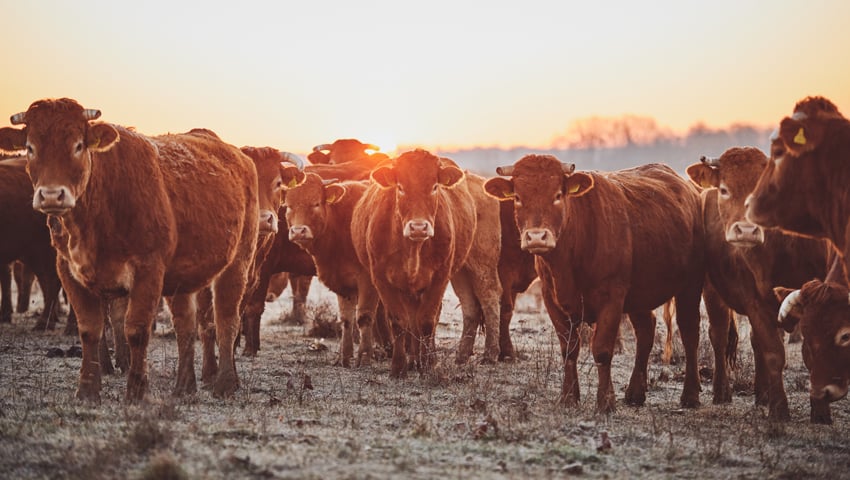Chris Smaje, author of Saying NO to a Farm-Free Future, continues to unpick the truth behind Joe Fassler’s five climate myths
Myth 4: Cattle are raised on lands where nothing else can grow anyway
HERE’S where it gets complicated. Fassler makes the welcome concession that “well-managed ruminant populations can be a helpful, symbiotic relationship with grassland ecosystems”. But he goes on to point out that this isn’t necessarily an argument for farmed livestock because species like bison, elk and deer can play the same role, and then correctly states that a lot of cattle are kept in places which are not native grasslands but have been cleared to make way for them – cleared, especially, of shrubs and trees. Drawing on the expertise of Tim Searchinger from the World Resources Institute he writes “Forests are a key ally in the climate fight, and the lost opportunity to store carbon in forests should be factored into the carbon cost of cattle production.”
What’s unquestionably true is that any new clearance of undisturbed habitat such as tropical rainforest for livestock agriculture today is bad for the climate, and in many other ways. But the opportunity cost argument against livestock on land that already sustains them is trickier, for three reasons.
First, newly established trees sequester carbon in the first few decades of their lives, but after that become essentially carbon neutral. So as a last-ditch attempt to save a habitable climate, there may be a case for widespread afforestation. As a first-ditch attempt while we’re still widening motorways, building airports and taking ocean cruises it looks like another narrative of prevarication, involving the huge risk that it becomes no more than an excuse for kicking the fossil fuel can down the road to the point where a habitable climate becomes unsavable however many trees we plant.
Second, the success of afforestation strategies in sequestering carbon depends a lot on local context and post-afforestation ecologies. Fire regimes, albedo and the profile of the wild organisms replacing grazed livestock (for example the methane-belching wild ruminants that Fassler mentions as alternatives to their domesticated cousins) can severely limit the cooling effect of the afforestation.
Landscapes over a wide swathe of the planet wouldn’t necessarily return to forest in the absence of human land management, and human attempts to afforest them can have severely negative ecological impacts.
Ecologist William Bond notes that a global mapping exercise undertaken by the World Resources Institute to identify ‘deforested’ and ‘degraded’ areas for afforestation included iconic old growth grassland and savanna areas such as the Serengeti and Kruger National Parks in this category. So while it’s certainly problematic to consider livestock simply as a resource that humans can expand at will, parallel thinking that considers trees as simply a resource that benefits the human fight against climate change can lead us into another world of trouble. The common thread is a mindset that thinks in terms of ‘world resources’ rather than local community needs.
Which brings us to the third reason. Much depends on human responses to the land use changes involved in afforestation. And human responses are notoriously difficult to model and to shape precisely through policy. Badly designed policies geared towards afforestation or against livestock farming can have numerous unintended consequences running counter to their intentions – among them, primary habitat encroachment, overgrazing, and short-termist commitments to ecologically impoverished secondary forest.
This isn’t an argument against wealthy consumers cutting their meat consumption. But it is an argument against stopping small-scale farmers from producing livestock and growing trees instead, purportedly for climate reasons. Livestock farming in any case is eminently compatible with many forested landscapes – though not, perhaps, the kind of livestock farming that’s selected for by the retail systems of the fossil-fuelled global economy. The main problem here is the nature of that economy, rather than livestock farming as such.
Earlier, I asked why livestock farmers were being singled out as methane villains. One answer that some of those farmers in upland areas of Britain are starting to articulate is that the corporations which dominate that economy would like to get hold of their land for afforestation schemes to plump their carbon offset claims. I daresay fossil energy companies are also happy for livestock farmers to have to face some of the music around climate concerns. Meanwhile, food industry players are positioning themselves around industrially synthesized high-protein biomass as a meat alternative.
In other words, a corporate anti-livestock agenda exists alongside the pro-livestock agenda that Fassler emphasizes. The offset part of it is short-termist and most likely spurious for numerous reasons, not least the non-ecological nature of planting poor quality secondary forest that will probably get cleared as soon as opportunity costs point a different way. Within pastoralist communities worldwide, there’s a fear that the real opportunity cost in play is not so much the cost of their livestock to the climate but the cost of their farms, their farm communities and their livelihoods to the greenwashing possibilities sought by governments and big business.
Read Smaje’s response to Myth one: fossil fuels
Read Smaje’s response to Myth two: methane
Read Smaje’s response to Myth three: beef
Read Smaje’s response to Myth five: future tech
